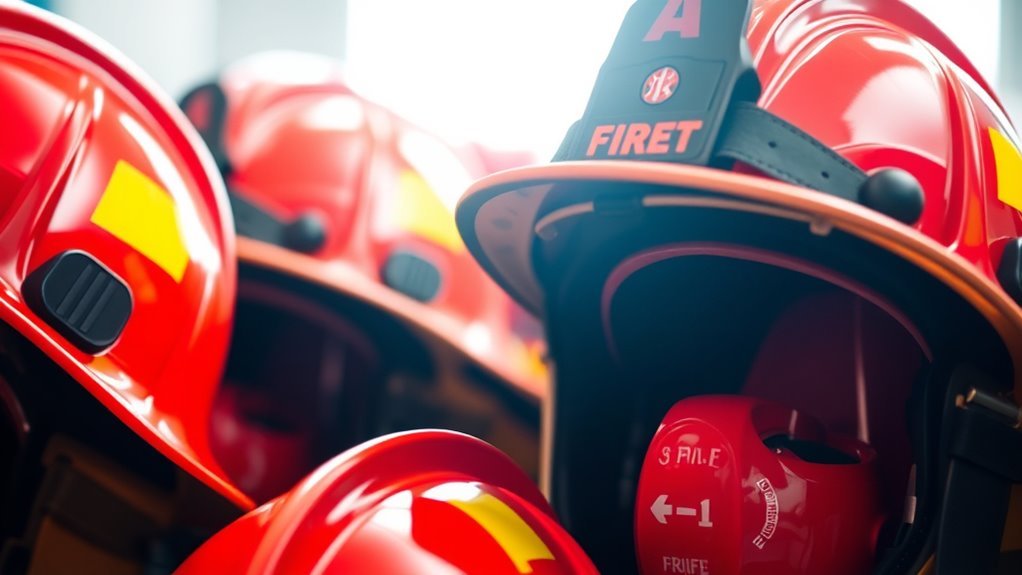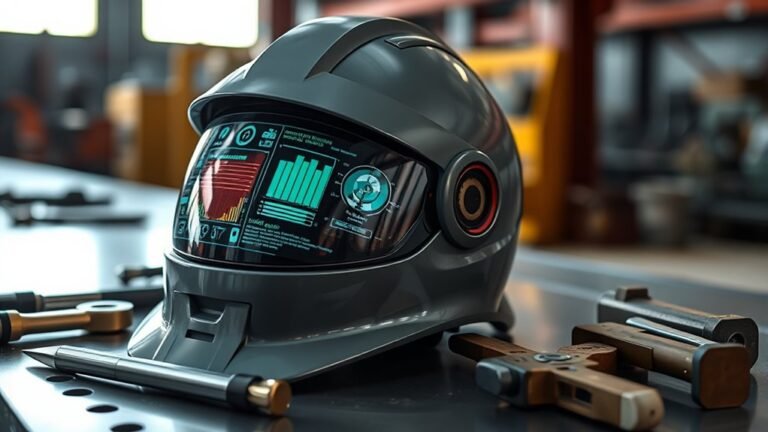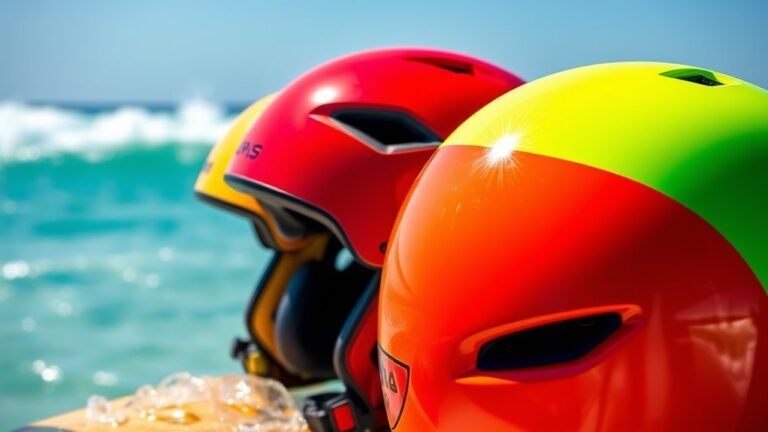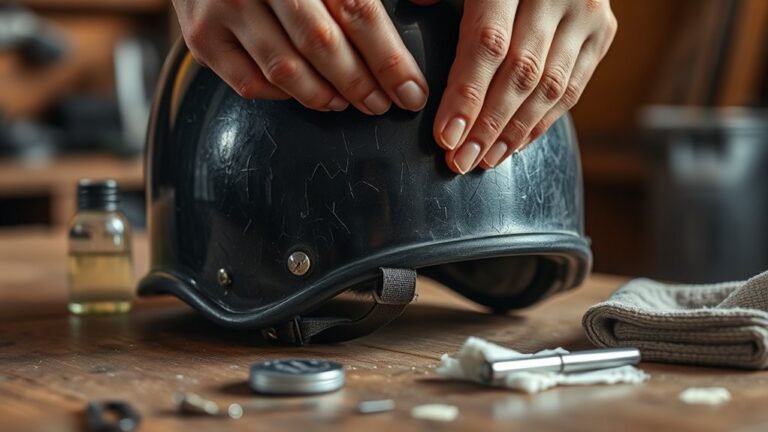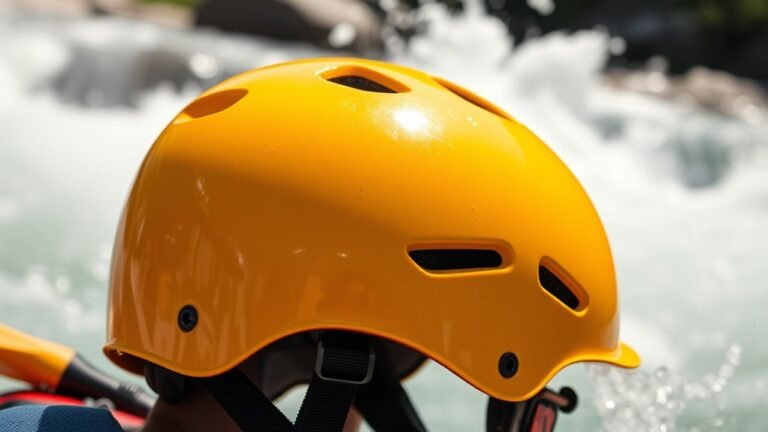Best Firefighter Helmets for Heat Resistance
When selecting the best firefighter helmets for heat resistance, look for models that meet NFPA 1971 standards. Prioritize helmets made with advanced materials like Kevlar or fiberglass for superior durability and heat dissipation. Features such as enhanced ventilation, impact-absorbing liners, and integrated communication systems also elevate performance. Brands like Bullard, Cairns, and MSA are recognized for their quality. If you want to explore specific models and their features, we can provide more insights.
Importance of Heat Resistance in Firefighter Helmets
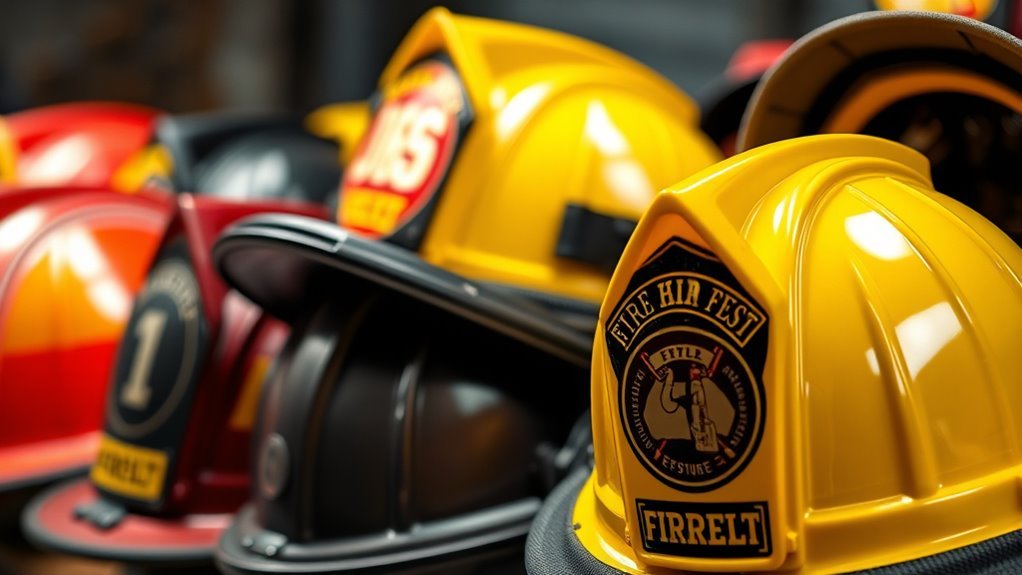
When you consider the dangers firefighters face, the importance of heat resistance in helmets becomes immediately apparent. Firefighters often encounter extreme heat exposure, making it essential for their helmets to provide reliable thermal protection. High temperatures can lead to severe injuries or even fatalities if adequate safeguards aren’t in place. Helmets designed with advanced materials, such as thermoplastics and reinforced composites, are engineered to withstand intense heat, ensuring that your head remains protected. Effective thermal protection not only minimizes the risk of burns but also enhances your ability to perform under pressure. By prioritizing heat resistance in helmet design, manufacturers empower you to navigate hazardous environments safely, ensuring you can focus on the mission without the constant threat of heat-related injuries.
Key Features to Look for in a Firefighter Helmet
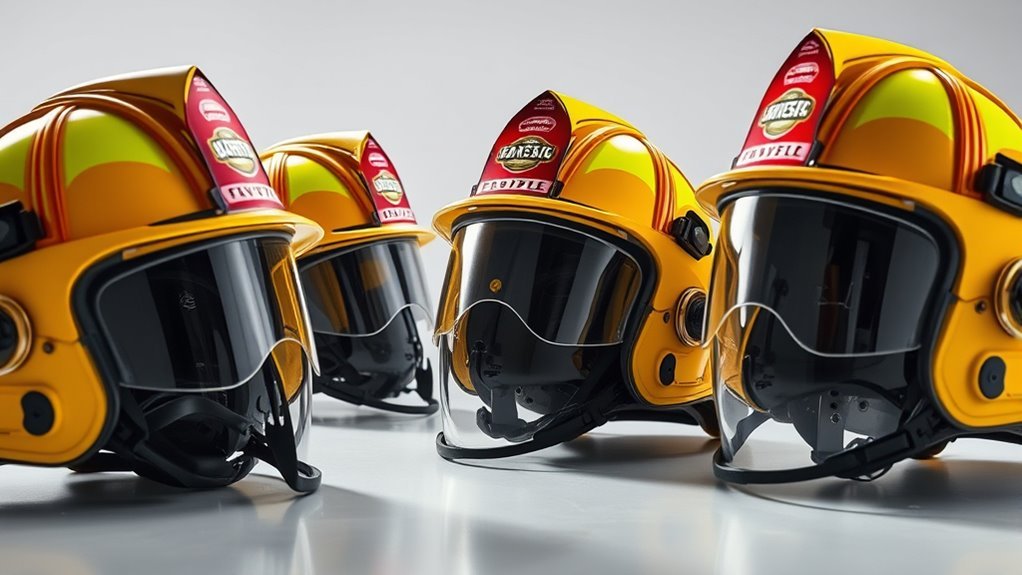
Choosing the right firefighter helmet involves understanding its essential features that secure safety and performance in extreme conditions. When selecting a helmet, consider the following key features:
| Feature | Description | Importance |
|---|---|---|
| Helmet Design | Lightweight, comfortable fit | Reduces fatigue during extended use |
| Material | Durable, heat-resistant materials | Guarantees longevity and protection |
| Safety Standards | Compliance with NFPA specifications | Secures reliability and safety |
| Visibility | High-visibility colors and reflective strips | Enhances safety in low-light situations |
| Accessories | Face shields, ear protection options | Provides additional safety and functionality |
Top Firefighter Helmets for Heat Resistance

Understanding the key features of firefighter helmets lays the groundwork for selecting models that excel in heat resistance. When choosing top firefighter helmet brands, look for those that adhere to helmet safety standards like NFPA 1971. Helmets constructed from advanced materials, such as Kevlar or fiberglass, provide superior heat dissipation. Notable brands include Bullard, Cairns, and MSA, known for their commitment to durability and protection. Consider helmets with enhanced thermal layers and face shields to optimize safety in extreme temperatures. Additionally, guarantee the design allows for proper ventilation without compromising structural integrity. By focusing on these aspects, you can identify helmets that not only meet safety regulations but also offer the freedom and confidence needed in high-risk situations.
Comparison of Popular Models
In today’s market, several firefighter helmet models stand out for their heat resistance and overall performance. When comparing these models, it’s essential to evaluate the specifications, such as interior lining, outer shell material, and impact resistance ratings. For instance, the Bullard PX900 offers superior durability with its fiberglass construction, while the Cairns 1044 boasts an aluminum shell for lightweight protection. You’ll find that both helmets excel in thermal resistance, but their model specifications cater to different preferences. Look for helmets that provide a balance between heat protection and comfort, ensuring they can withstand extreme conditions without sacrificing durability. Ultimately, selecting the right helmet involves examining your needs and understanding the strengths of each model regarding heat resistance and durability.
Maintenance Tips for Firefighter Helmets
Proper maintenance of firefighter helmets is essential for ensuring their longevity and effectiveness in protecting against heat and impact. Regular helmet cleaning is vital; use a mild soap and water solution to remove dirt and contaminants. Avoid harsh chemicals that could degrade materials. After each use, conduct a damage inspection to check for cracks, dents, or any signs of wear. Pay special attention to the helmet’s inner foam and suspension system, as these are critical for comfort and safety. If you notice any significant damage, replace the helmet immediately. Store your helmet in a cool, dry place, away from direct sunlight, to prevent material degradation. Consistent care will extend its life and preserve its protective capabilities.
How to Choose the Right Fit
How can you guarantee that your firefighter helmet fits correctly? Start by measuring your head’s circumference just above your ears. Once you have your measurement, consult the manufacturer’s sizing chart to find the appropriate size. Most helmets come with a size adjustment feature, allowing you to customize the fit for maximum security. It’s essential that the helmet sits snugly without being too tight, as this affects comfort levels during long shifts. Look for padding that conforms to your head shape, ensuring you won’t experience discomfort or distraction while working. Finally, always try on the helmet in full gear to confirm it meets your needs before heading into the field. A proper fit not only enhances safety but also boosts your confidence.
Innovations in Firefighter Helmet Technology
In recent years, firefighter helmet technology has greatly evolved to enhance safety and performance. You’ll find advanced materials that improve heat resistance, along with enhanced ventilation systems that promote airflow during intense operations. Additionally, integrated communication features are becoming standard, ensuring firefighters can stay connected in the field.
Advanced Material Usage
As firefighting techniques evolve, the materials used in helmet construction have also advanced considerably, enhancing both safety and functionality. Modern firefighter helmets now incorporate innovative materials like carbon fiber and aramid fibers, offering exceptional heat resistance and durability. These materials not only reduce weight but also improve impact protection, allowing you to focus on the task at hand without compromising safety.
- Carbon Fiber: Lightweight yet incredibly strong.
- Aramid Fibers: Excellent heat and abrasion resistance.
- Thermal Barriers: Protect against extreme temperatures.
- Composite Materials: Combine multiple benefits for enhanced performance.
- Energy-Absorbing Liners: Mitigate impact forces effectively.
With these advancements, you’re better equipped to face the challenges of firefighting while ensuring your safety remains a top priority.
Enhanced Ventilation Systems
While battling intense fires, maintaining comfort and focus is essential for firefighters, and that’s where enhanced ventilation systems in helmets come into play. These systems utilize advanced ventilation design to optimize airflow efficiency, ensuring that heat and moisture are effectively managed. By incorporating strategically placed vents and channels, modern helmets allow for increased air circulation, reducing the risk of overheating during prolonged exposure to extreme conditions. This innovative approach not only enhances comfort but also improves concentration, enabling you to stay alert and make quick decisions in critical situations. With improved airflow, you can focus on the task at hand, knowing your helmet is working to keep you cool and safe in high-stress environments.
Integrated Communication Features
Enhanced ventilation systems have set a foundation for further innovations in firefighter helmet technology, particularly in integrated communication features. Modern firefighter helmets are now equipped with advanced communication devices to guarantee seamless interaction in high-stress environments. These innovations enhance sound clarity, allowing for clear communication among team members, which is vital during emergencies.
- Built-in microphones for hands-free communication
- Noise-canceling technology to filter out background sounds
- Bluetooth connectivity for mobile device integration
- Voice-activated controls for ease of use
- Real-time information sharing through helmet displays
With these features, you gain the freedom to focus on safety while maintaining reliable communication, enhancing overall operational efficiency during firefighting missions.
Frequently Asked Questions
How Much Do High-Quality Firefighter Helmets Typically Cost?
When you’re maneuvering through the flames of your duty, investing in a high-quality firefighter helmet typically costs between $200 to $1,200. Think of it as equipping your armor for battle; budget options might skimp on essential helmet features like heat resistance and durability. You wouldn’t charge into a storm without the right gear. So, balance your budget wisely, ensuring you get the protection you need to safeguard your freedom and life.
Can Firefighter Helmets Be Customized for Individual Firefighters?
Yes, firefighter helmets can be customized for individual firefighters. Many manufacturers offer custom helmet designs that allow you to choose colors, decals, and other features to reflect your department or personal style. Additionally, personalized fittings guarantee the helmet fits snugly and comfortably, enhancing safety and effectiveness during operations. This level of customization not only improves functionality but also fosters a sense of identity and pride among firefighters on the team.
What Is the Lifespan of a Firefighter Helmet?
A firefighter helmet typically lasts around 10 years, depending on the helmet materials and usage conditions. Helmets made from advanced polymers or composites can offer enhanced durability, but exposure to extreme heat, chemicals, or physical impact can accelerate deterioration. It’s essential to adhere to safety standards, as they guarantee helmets provide the necessary protection. Regular inspections and maintenance can help you determine if it’s time for a replacement, safeguarding your safety on the job.
Are There Specific Certifications for Firefighter Helmets?
Yes, there are specific certifications for firefighter helmets. Helmets must meet established certification standards, like those set by the National Fire Protection Association (NFPA) or Underwriters Laboratories (UL). These standards guarantee helmets undergo rigorous helmet testing for impact resistance, heat tolerance, and other critical safety factors. By choosing a certified helmet, you’re guaranteeing your gear provides the protection you need, allowing you to focus on your duties without compromising safety.
How Do I Know When to Replace My Helmet?
Your helmet’s like a trusted shield; when it shows signs of damage, it’s time to retire it. Regularly perform a helmet inspection checklist, looking for cracks, dents, or wear. If you notice significant discoloration or the inner padding is deteriorating, it’s a clear signal. Additionally, if it’s been exposed to extreme heat or impact, don’t hesitate to replace it. Your safety is paramount, and a compromised helmet isn’t worth the risk.
